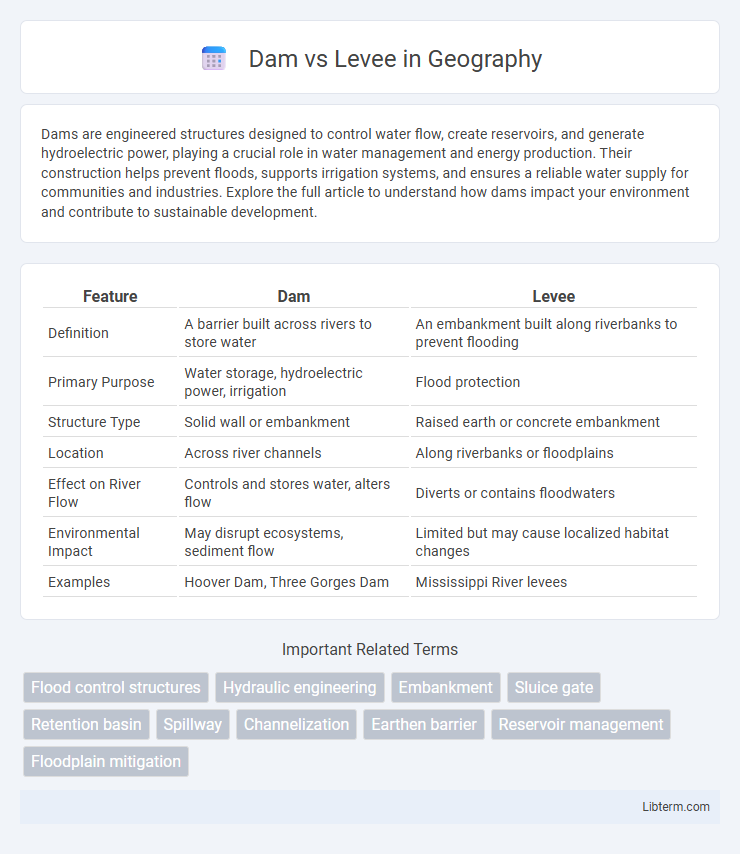Dams are engineered structures designed to control water flow, create reservoirs, and generate hydroelectric power, playing a crucial role in water management and energy production. Their construction helps prevent floods, supports irrigation systems, and ensures a reliable water supply for communities and industries. Explore the full article to understand how dams impact your environment and contribute to sustainable development.
Table of Comparison
| Feature | Dam | Levee |
|---|---|---|
| Definition | A barrier built across rivers to store water | An embankment built along riverbanks to prevent flooding |
| Primary Purpose | Water storage, hydroelectric power, irrigation | Flood protection |
| Structure Type | Solid wall or embankment | Raised earth or concrete embankment |
| Location | Across river channels | Along riverbanks or floodplains |
| Effect on River Flow | Controls and stores water, alters flow | Diverts or contains floodwaters |
| Environmental Impact | May disrupt ecosystems, sediment flow | Limited but may cause localized habitat changes |
| Examples | Hoover Dam, Three Gorges Dam | Mississippi River levees |
Introduction to Dams and Levees
Dams are engineered structures built across rivers or streams to store water, control floods, and generate hydroelectric power, often creating reservoirs. Levees are embankments constructed alongside rivers or coastlines to prevent flooding by containing or redirecting water flow during high water events. Both dams and levees serve crucial roles in water management but differ fundamentally in design, purpose, and scale.
Definition: What is a Dam?
A dam is a large engineered structure built across rivers or streams to store, manage, and control water flow for purposes such as irrigation, hydroelectric power generation, flood control, and water supply. Unlike levees, which are embankments designed primarily to prevent flooding by containing river water, dams create reservoirs by holding back water in a controlled manner. Essential components of a dam include a sturdy wall, spillways, and outlet works to regulate water release and maintain structural integrity.
Definition: What is a Levee?
A levee is an engineered embankment or ridge constructed along rivers, lakes, or coastal areas to prevent flooding by containing or diverting water flow. Unlike a dam, which typically blocks or stores water to form reservoirs, levees serve primarily as barriers to protect adjacent land from water overflow. These structures are often made of earth, concrete, or other materials and are crucial in flood management systems.
Primary Functions of Dams vs Levees
Dams primarily function to store water, generate hydroelectric power, and control floods by regulating river flow. Levees primarily serve as embankments designed to prevent river water from flooding adjacent land, protecting populated and agricultural areas. While dams manage water on a large scale by creating reservoirs, levees act as barriers along riverbanks to contain high water levels during flood events.
Structural Differences: Dam vs Levee
Dams are large, rigid structures built across rivers or streams to store water, create reservoirs, and generate hydroelectric power, characterized by their massive concrete or earth-fill barriers designed to hold significant volumes of water. Levees are elongated embankments or walls constructed along riverbanks or coastlines primarily to prevent flooding by containing or redirecting water flow, typically made from earth, sand, or other earthen materials. The key structural difference lies in a dam's function as a water retention facility with substantial height and thickness, while levees serve as protective barriers with greater length but comparatively lower height and structural rigidity.
Types and Variations of Dams
Dams vary widely, including gravity, arch, buttress, and embankment types, each designed for specific geological and hydrological conditions. Gravity dams rely on their weight to hold back water, while arch dams transfer water pressure to side walls, and buttress dams use supports to resist the water load. Embankment dams, made from earth or rock fill, are highly adaptable and often used in wide valleys.
Types and Variations of Levees
Levees are embankments constructed primarily to prevent flooding from rivers, estuaries, or coastal areas, differing from dams by allowing controlled water flow rather than entirely blocking it. Types of levees include earthen levees made from compacted soil, floodwalls constructed from concrete or steel for urban areas, and ring levees that encircle a specific area for localized protection. Variations also encompass setback levees, which are built at a distance from the riverbank to create a floodplain buffer, and levees integrated with pumping stations to manage water levels efficiently.
Key Advantages: Dams Compared to Levees
Dams offer superior water storage capacity, enabling effective flood control, hydroelectric power generation, and irrigation support, unlike levees which primarily serve as barriers to contain river overflow. They create large reservoirs that regulate water flow, enhancing drought resilience and ensuring consistent water supply, whereas levees only stabilize riverbanks and provide limited flood protection. The structural design of dams allows for multi-purpose usage, integrating energy production and water management, making them more versatile compared to the singular focus of levees on flood defense.
Common Challenges and Risks
Dams and levees both face common challenges such as structural integrity under extreme weather events, sediment buildup, and erosion, which can compromise their safety and functionality. Risk factors include potential overtopping, foundation instability, and inadequate maintenance leading to breaches or failures. Emergency preparedness and consistent monitoring are critical to mitigating the hazards associated with both dam and levee infrastructures.
Environmental Impact: Dam vs Levee
Dams often create large reservoirs that can submerge ecosystems, disrupt fish migration, and alter natural sediment flow, leading to significant environmental changes. Levees primarily prevent flooding by restraining river overflow, but they can increase downstream flood risk and degrade wetland habitats by disconnecting rivers from their floodplains. Both structures impact biodiversity and water quality, yet dams typically cause more extensive ecological transformation due to their scale and permanent water retention.
Dam Infographic

 libterm.com
libterm.com